Method and apparatus for maximizing nitrogen removal from wastewater
- Summary
- Abstract
- Description
- Claims
- Application Information
AI Technical Summary
Benefits of technology
Problems solved by technology
Method used
Image
Examples
examples
[0050]The system for removing nitrogen in a reactor for biological nitrogen removal from wastewaters of the present disclosure was operated with 2-3 hr hydraulic residence time (HRT), ˜5 day SRT, 3500±500 mg / L mixed liquor suspended solids (MLSS) at 25° C. The reactor was operated under the AVN control strategies set forth at paragraph [0047] (above) and shown in FIGS. 5-6. FIG. 9 represents the NOB repression that was observed. The AVN controller performance is demonstrated in FIG. 12. As seen in FIG. 13, high TIN removal, wherein the removal was dependent on COD input, was also achieved using the same operating conditions.
Relevant Acronyms:
[0051]AOB: ammonia oxidizing bacteria[0052]BNR: biological nutrient removal[0053]COD: chemical oxygen demand[0054]C / N: Carbon to nitrogen ratio[0055]DO: dissolved oxygen[0056]FA: free ammonia[0057]HDO: high DO[0058]HRT: hydraulic residence time[0059]LDO: low DO[0060]NOB: nitrite oxidizing bacteria[0061]NOx: Nitrate[0062]NOx—N: Nitrate-nitrogen p...
PUM
 Login to View More
Login to View More Abstract
Description
Claims
Application Information
 Login to View More
Login to View More - R&D Engineer
- R&D Manager
- IP Professional
- Industry Leading Data Capabilities
- Powerful AI technology
- Patent DNA Extraction
Browse by: Latest US Patents, China's latest patents, Technical Efficacy Thesaurus, Application Domain, Technology Topic, Popular Technical Reports.
© 2024 PatSnap. All rights reserved.Legal|Privacy policy|Modern Slavery Act Transparency Statement|Sitemap|About US| Contact US: help@patsnap.com










